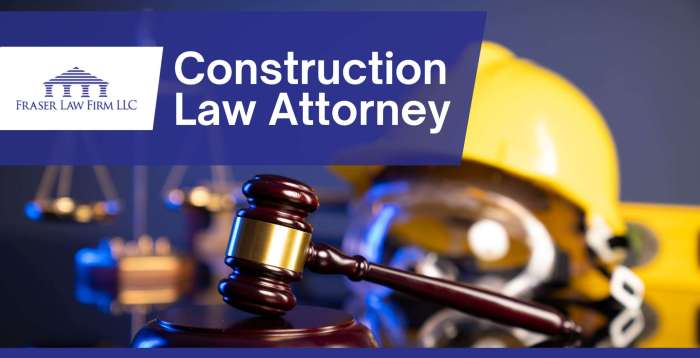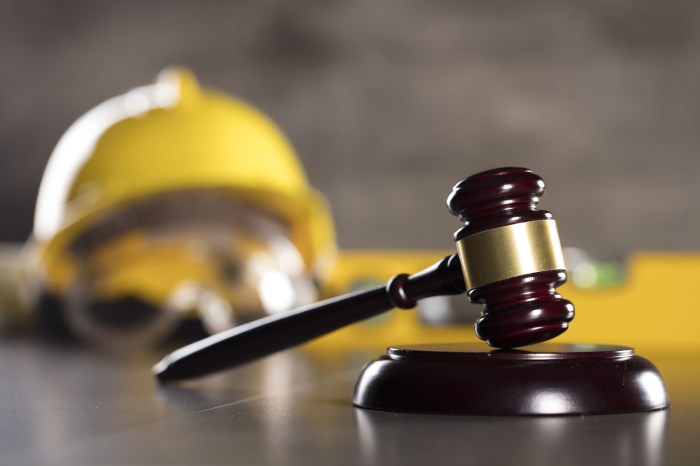Attorney for construction law, an indispensable ally in the intricate world of construction, provides expert guidance and representation to navigate legal complexities and ensure project success. From contract drafting to dispute resolution, our attorneys are equipped to safeguard your interests and drive favorable outcomes.
Our comprehensive understanding of construction law empowers us to provide tailored solutions for every project phase. We work closely with clients to understand their unique needs and objectives, ensuring their vision is translated into legally sound contracts and effectively executed projects.
Construction Law Overview: Attorney For Construction Law
Construction law is a specialized area of law that governs the legal relationships between parties involved in construction projects. It encompasses a wide range of issues, including contract drafting and negotiation, construction litigation, construction arbitration and mediation, and construction insurance.
Attorneys who specialize in construction law play a vital role in resolving disputes between parties involved in construction projects. They can help draft and negotiate construction contracts, represent clients in construction litigation, and provide guidance on construction insurance coverage.
Common Types of Construction Disputes
- Breach of contract
- Construction defects
- Payment disputes
- Delay claims
- Insurance coverage disputes
Legal Process for Resolving Construction Disputes
- Negotiation
- Mediation
- Arbitration
- Litigation
Common Construction Law Issues

The construction industry presents a unique set of legal challenges that can arise at any stage of a project. These issues can have a significant impact on the project’s timeline, budget, and relationships between the parties involved.
Understanding the common legal issues faced in construction projects is crucial for mitigating risks and ensuring a successful outcome. By identifying potential pitfalls and implementing proactive measures, contractors and owners can safeguard their interests and minimize the likelihood of disputes.
Contract Drafting, Interpretation, and Enforcement
Construction contracts are complex legal documents that define the rights and obligations of the parties involved. Issues can arise from poorly drafted contracts, differing interpretations of contract terms, or disputes over contract enforcement. Clear and comprehensive contract drafting is essential to avoid misunderstandings and ensure that the project proceeds as intended.
Project Delays and Cost Overruns
Project delays and cost overruns are common challenges in the construction industry. These issues can be caused by various factors, including weather conditions, labor shortages, material availability, and unforeseen circumstances. Understanding the legal implications of delays and cost overruns is crucial for mitigating their impact and preserving the rights of all parties.
Legal Remedies for Disputes
When disputes arise in construction projects, it is important to understand the legal remedies available to contractors and owners. These remedies may include breach of contract claims, mechanic’s liens, and arbitration or litigation. Choosing the appropriate legal remedy depends on the specific circumstances of the dispute and the desired outcome.
Insurance and Bonding in Construction Projects
Insurance and bonding play a vital role in protecting the parties involved in construction projects. Insurance policies provide coverage for various risks, such as property damage, bodily injury, and professional liability. Bonding provides financial protection for owners in the event of contractor default or failure to perform.
Types of Construction Disputes

Construction disputes can arise from various sources, including contractual breaches, delays, cost overruns, and defective workmanship. Understanding the different types of disputes and the legal remedies available is crucial for effective resolution.
Breach of Contract
Breach of contract occurs when one party fails to fulfill their contractual obligations. This can include failure to complete the project on time, within budget, or according to specifications. Legal remedies for breach of contract may include damages (monetary compensation), specific performance (requiring the party to fulfill their obligations), or rescission (cancellation of the contract).
Delay Disputes
Delay disputes arise when a project is not completed on time. This can be caused by various factors, such as weather conditions, labor shortages, or material delays. Legal remedies for delay disputes may include extensions of time, liquidated damages (predetermined compensation for delays), or claims for additional costs incurred due to the delay.
Cost Overruns
Cost overruns occur when the actual cost of the project exceeds the agreed-upon budget. This can be caused by unexpected expenses, changes in the scope of work, or inefficiencies. Legal remedies for cost overruns may include claims for additional payment, adjustments to the contract price, or disputes over the allocation of costs.
Defective Workmanship
Defective workmanship occurs when the completed project does not meet the agreed-upon specifications or industry standards. This can include structural defects, faulty materials, or poor craftsmanship. Legal remedies for defective workmanship may include repairs or replacements, deductions from the contract price, or claims for damages.
Construction Contracts
Construction contracts are legally binding agreements between parties involved in a construction project, outlining the terms and conditions of the project. They define the scope of work, payment terms, timelines, and responsibilities of each party. Analyzing key provisions in construction contracts is crucial to ensure a smooth and successful project.
Key Provisions in Construction Contracts
- Scope of Work:Clearly defines the project’s objectives, including the specific tasks to be completed and the materials to be used.
- Payment Terms:Artikels the payment schedule, including the amount, timing, and method of payment.
- Timelines:Establishes the project’s start and completion dates, as well as intermediate milestones.
- Responsibilities:Specifies the roles and responsibilities of the contractor, subcontractor, architect, and owner.
- Dispute Resolution:Provides mechanisms for resolving disputes, such as mediation, arbitration, or litigation.
Construction Insurance
Construction insurance plays a crucial role in protecting all parties involved in construction projects from financial risks and uncertainties. It provides a safety net against potential liabilities, property damage, and accidents that may arise during the construction process.Different types of insurance coverage are available to address the specific risks associated with construction projects.
These include:
- General Liability Insurance:Covers claims for bodily injury, property damage, or advertising injury caused by the contractor’s operations.
- Builders Risk Insurance:Protects the physical assets of the project, such as materials, equipment, and the structure itself, from damage or loss due to covered perils.
- Workers’ Compensation Insurance:Provides medical and wage replacement benefits to employees who suffer work-related injuries or illnesses.
- Performance and Payment Bonds:Guarantees that the contractor will complete the project according to the contract terms and pays subcontractors and suppliers.
Dispute Resolution Methods
In the realm of construction law, disputes can arise from various sources, leading to the need for effective resolution mechanisms. Alternative dispute resolution (ADR) methods offer alternatives to traditional litigation, providing a more flexible and often less adversarial approach to conflict resolution.
Litigation vs. ADR
Litigationinvolves the formal process of filing a lawsuit in court, where a judge or jury decides the outcome. It can be time-consuming, costly, and adversarial, with limited opportunities for compromise or settlement.
In contrast, ADRencompasses a range of non-judicial methods that aim to resolve disputes outside of the courtroom. ADR methods prioritize collaboration, negotiation, and compromise, often leading to mutually acceptable outcomes.
- Mediation: A neutral third party facilitates discussions between disputing parties, guiding them toward a mutually agreeable solution.
- Arbitration: A neutral third party (arbitrator) hears evidence from both parties and renders a binding decision, similar to a court judgment.
- Negotiation: Parties directly engage in discussions and negotiations to reach a compromise or settlement without the involvement of a third party.
- Conciliation: A neutral third party helps parties identify common ground, facilitate communication, and explore settlement options.
ADR methods offer several advantages over litigation, including:
- Flexibility: ADR can be tailored to the specific needs and preferences of the parties involved.
- Confidentiality: ADR proceedings are generally private, protecting sensitive information from public disclosure.
- Cost-effectiveness: ADR methods are often less expensive than litigation.
- Timeliness: ADR can often resolve disputes more quickly than litigation.
Legal Ethics in Construction Law

Ethical considerations are paramount in construction law, guiding attorneys’ conduct and ensuring fairness and integrity in the legal process. Understanding and adhering to these ethical principles is crucial for attorneys practicing in this field.
Conflicts of Interest
Conflicts of interest arise when an attorney’s personal or professional interests interfere with their ability to represent a client objectively. In construction law, conflicts can arise due to prior relationships, financial interests, or other circumstances.
- Example:An attorney representing a contractor in a construction dispute cannot represent the subcontractor in the same dispute, as this would create a conflict of interest.
Attorneys must take steps to avoid conflicts of interest, including:
- Thoroughly investigating potential conflicts before accepting representation.
- Disclosing any potential conflicts to clients and obtaining their informed consent.
- Withdrawing from representation if a conflict cannot be resolved.
Consequences of Violating Ethical Rules
Violating ethical rules can have serious consequences for attorneys, including:
- Disciplinary action by the state bar.
- Loss of reputation and credibility.
- Malpractice claims.
Resources for Attorneys
The American Bar Association (ABA) and state bar associations provide resources and guidance on legal ethics in construction law, including:
- Model Rules of Professional Conduct.
- Ethical opinions.
- Continuing legal education (CLE) programs.
Emerging Trends in Construction Law

The construction industry is constantly evolving, and with it, the legal landscape. Construction companies need to be aware of these emerging trends in order to prepare for and adapt to the changes that are coming.One of the most significant emerging trends in construction law is the use of technology.
Drones, virtual reality (VR), and augmented reality (AR) are all being used to improve the efficiency and safety of construction projects. Blockchain technology is also being used to create more transparent and secure supply chains.Another emerging trend is the focus on sustainability.
Construction companies are increasingly using green building materials and renewable energy sources to reduce their environmental impact. They are also finding ways to reduce waste and improve the sustainability of their construction projects.The gig economy is also having an impact on the construction industry.
More and more construction companies are using independent contractors and subcontractors to complete projects. This can provide flexibility and cost savings, but it can also create challenges in terms of quality control and safety.Finally, the Internet of Things (IoT) is also having an impact on the construction industry.
IoT devices can be used to collect data on everything from the temperature of a building to the amount of energy being used. This data can be used to improve the efficiency and safety of construction projects.These are just a few of the emerging trends in construction law.
Construction companies need to be aware of these trends and be prepared to adapt to the changes that are coming.
Case Studies
Landmark construction law cases establish legal precedents and principles that guide the industry. Analyzing these cases provides valuable insights into the complexities of construction law and its implications for all parties involved.
By examining the legal principles and outcomes of landmark cases, we can identify common patterns, anticipate potential legal issues, and develop effective strategies for mitigating risks and resolving disputes.
Landmark Construction Law Cases
- Pinnacle Port Community Urban Renewal Corp. v. American States Insurance Co.: This case clarified the interpretation of “completed operations” in commercial general liability insurance policies, determining that the duty to defend only arises when the injury or damage occurs after the project’s completion.
- Altair Airlines, Inc. v. Northrop Corp.: This case established the concept of “economic loss” in construction law, holding that purely economic losses (without physical damage to property) are not recoverable in tort.
- Perini Corp. v. Commonwealth of Massachusetts: This case addressed the issue of delay damages, establishing that contractors can recover damages for delays caused by the owner’s breach of contract, even if the delay does not result in additional costs.
Best Practices for Attorneys
In the intricate realm of construction law, attorneys play a pivotal role in safeguarding the interests of their clients. Embracing best practices empowers them to navigate disputes with finesse, achieving optimal outcomes for those they represent.
Effective communication forms the cornerstone of successful attorney-client relationships. Attorneys must possess exceptional listening skills, attentively comprehending their clients’ concerns and objectives. Clear and concise communication ensures clients fully understand their legal rights and options, fostering trust and collaboration.
Negotiation Strategies
- Prepare meticulously: Thoroughly research the case, identifying potential strengths and weaknesses. Anticipate the opposing party’s arguments and develop compelling counterarguments.
- Build rapport: Establishing a positive rapport with the opposing counsel can facilitate productive negotiations. Respectful and professional communication sets the stage for constructive dialogue.
- Explore creative solutions: Beyond traditional approaches, consider innovative solutions that address both parties’ interests. Flexibility and a willingness to compromise can unlock mutually beneficial outcomes.
Create an Infographic

Visualizing the key aspects of construction law can make it easier to understand the complexities of this field. An infographic can be a valuable tool for summarizing the most important points, highlighting statistics and data, and providing a visually appealing representation of the subject matter.
When creating an infographic on construction law, it is important to focus on the most important points and present them in a clear and concise manner. The infographic should be visually appealing and easy to understand, with the use of statistics, data, and visuals to support the key points.
Design
- Use a visually appealing design that is easy to understand.
- Use a clear and concise font that is easy to read.
- Use colors and graphics to highlight important points.
- Keep the infographic simple and uncluttered.
Content
- Include statistics and data to support the key points.
- Use visuals to illustrate the key points.
- Highlight the most important points of construction law.
- Include a call to action for readers to learn more about construction law.
Call to Action, Attorney for construction law
The infographic should include a call to action for readers to learn more about construction law. This could be a link to a website, a blog post, or a contact form. The call to action should be clear and concise, and it should encourage readers to take the next step.
Organize a Q&A Table

Stay informed with this comprehensive Q&A table that addresses common construction law queries.
FAQs
Find answers to frequently asked questions and gain a clearer understanding of construction law.
| Question | Answer |
|---|---|
| What are the key elements of a construction contract? | Scope of work, payment terms, timelines, and dispute resolution mechanisms. |
| What are the common types of construction disputes? | Breach of contract, delays, payment disputes, and construction defects. |
| How can construction disputes be resolved? | Negotiation, mediation, arbitration, and litigation. |
| What are the ethical obligations of attorneys in construction law? | Uphold client confidentiality, avoid conflicts of interest, and provide competent legal advice. |
| What are some emerging trends in construction law? | Green building regulations, sustainability initiatives, and the use of technology in construction. |
Write a Legal Blog Post
Drafting a well-structured and informative legal blog post on construction law requires careful planning and execution. By following specific guidelines and including relevant citations and case studies, you can create a valuable resource for your readers.
To begin, choose a specific construction law topic that is both timely and relevant to your target audience. Research the topic thoroughly, ensuring that you have a comprehensive understanding of the legal principles involved. Incorporate citations to legal authorities, such as statutes, regulations, and case law, to support your arguments and provide credibility to your post.
Case Studies
Case studies can be particularly effective in illustrating complex legal concepts and demonstrating how they are applied in real-world situations. Choose cases that are relevant to your topic and that provide valuable insights into the legal issues involved. Be sure to analyze the cases thoroughly and explain their significance to your readers.
End of Discussion
In the dynamic landscape of construction law, our attorneys remain at the forefront, embracing emerging trends and legal developments to provide cutting-edge counsel. With a commitment to excellence and unwavering dedication to our clients, we stand as your trusted advisors, ensuring your construction endeavors are built on a solid legal foundation.
FAQ Explained
What is the role of an attorney for construction law?
An attorney for construction law provides legal guidance and representation to clients involved in construction projects, assisting with contract drafting, dispute resolution, and ensuring compliance with industry regulations.
What types of disputes can an attorney for construction law help resolve?
Attorneys for construction law can assist with a wide range of disputes, including contract breaches, payment disputes, delays, and construction defects.
How can an attorney for construction law help with contract drafting?
Attorneys for construction law can help draft and review construction contracts, ensuring they are clear, comprehensive, and protect the interests of all parties involved.